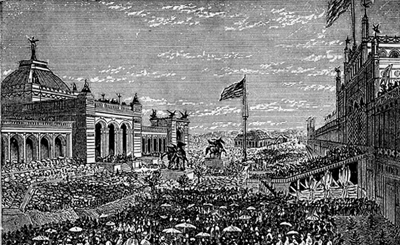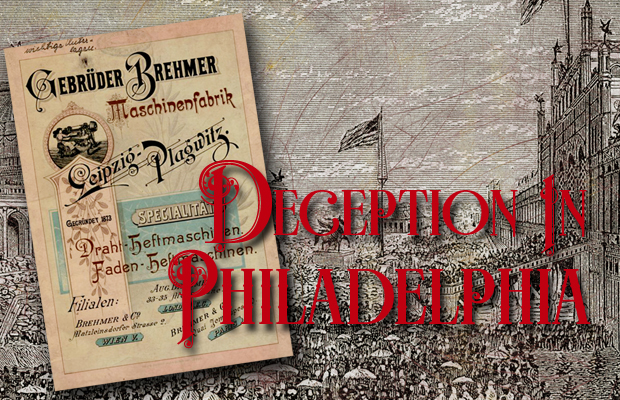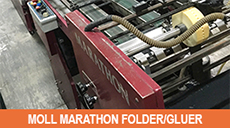Ever since the invention of
the wheel, great ideas have
not only been eclipsed,
they have been stolen. The
R. Hoe Company, once a
mammoth builder of newspaper presses,
had incredible scandals and court case.
George Gordon snapped Stephen Ruggles
ideas for a platen press then fought
for years to protect his trumped patents.
In more contemporary times, many
German offset technologies have shown
up elsewhere as near identical clones,
which were eventually adapted to stand
for their own quality. The passage of time
allows us to learn valuable lessons about
the evolution of printing technology.
Heyl and the Brothers Brehmer
Take for instance the story of Mr. Henry
Heyl and the Brehmer brothers. These
three men had a major impact on the
printing industry. One a gifted inventor,
the others observant partners. Their
story illustrates how little has changed in
the way ambitious people, in pursuit of
fame and fortune, live their lives.
Henry Renno Heyl, an American, was
born in Columbus, Ohio, around 1842,
when America was an incubator of industrial
innovation. In 1870, Heyl invented
the world’s first device for projecting
[moving] pictures on a screen. In front of
1,600 people, in Philadelphia, Heyl demonstrated
his invention but never patented
it. Well before Edison, the Phasmatrope
showed a group of still images
(himself and his niece) mounted onto a
stereopticon projector. When the wheel
holding the glass images rotated, the
projector cast the images with candlelight
onto a screen and created the illusion of
motion. Heyl could be thought of as the
father of the movie industry.
Many other important printing innovations
followed. A folding cardboard box
machine was patented in 1871. Previously,
almost all goods were wrapped in
paper and tied with string. Heyl’s machine
folded and glued a collapsible box
and revolutionized what today is a major
part of the industry. Perhaps we should
also credit Heyl as being the father of the
paper box industry too. Matchbox and
tag making machinery was also invented
by Heyl, who also received credit for
fashioning the office stapler. All of this
took place in Philadelphia.
One giant book-making bottleneck
caught Henry’s eye in the 1870s: Hand
sewing of signatures. American Sterling
Elliott had invented a device to pierce
and thread pamphlets. It even tied a knot
at the end stroke, but ultimately made
bulky signatures terrible for case binding.
Ellicott Averell from Brooklyn, NY,
developed a wire stitcher in 1874. It was
patented as the first machine to stitch
book blocks onto a spine. Very little became
of it, but the invention attracted
many eyeballs, among them a Canadian.
Louis Goddu was a shoemaker born
in Quebec. Presumably noticing Averell’s
machine, he made further inroads using
wire. Goddu was a prolific inventor, patenting
several automations (300 in total)
primarily in the shoe industry, sewing,
nailing and tacking machinery. He is
considered as one of the early innovators
of the staple. Working from his new home
outside Boston, Goddu went on to build
his own car, which included a first of its
kind overhead camshaft. With a new
material called drawn wire, the American
industry soon expanded but mainly for
flat stitching with single-head machinery.
Even with the advent of wire staple,
thread sewing was still being done by
hand. Northern Irishman David Mc-
Connell Smyth, who arrived in America
in 1835 at age two, would eventually solve
the thread-sewn dilemma. Though
Smyth didn’t invent the sewing machine
(Elias Howe, 1830s, patented in 1846),
Smyth did move this technology into the
bindery in 1867 (patented 1871). As pictures
testify, the early days of stitching a
signature with a Smyth sewer were
daunting, but the machine eventually
paved the way to a thread sewing standard
in the industry. Even today we refer
to a quality stitch as Smyth Sewn. It
would be many years, however, before
the massive book industry accepted the
Smyth system, leaving a giant hole to
be filled.
The advent of book binding
Having already worked with drawn metal
wire, Henry Heyl entered the scene because
of the upcoming Philadelphia’s
Centennial Exposition in 1876. He aimed
to build a machine that would use metal
wire instead of thread to automatically
stitch a signature. Heyl wanted to produce
a million copies of a special edition
book for the Exposition. He modified a
standard sewing machine to feed wire
capable of making 1/4-inch staples at a
rate of 50 per minute. The Centennial
books were delivered on time.
 |
The Centennial Exposition, first official World's Fair in the United States, was held in Philadelphia in celebration of the 100th anniversary of the signing of the Declaration of Independence. Nearly 10 million visitors attended. |
Two brothers
newly arrived from Germany, who
owned a small Philadelphia machine
shop, helped Heyl build his device, what
would be referred to as the Heyl #2.
Word about the breakthrough spread
quickly and the U.S. Government Printing
Office ordered 13 Heyl #2 machines,
which also stitched signatures by alternating
the pattern so that spines were
much less bulky. Women could feed and
stitch as fast as they were able. By 1881,
more than 300 Heyl #2 machines were
sold.
The German Brehmer brothers were
similarly talented machinists. Although
both had immigrated to America in 1871
from Lübeck, they quickly realized the
impact an automated stitcher would have
in Leipzig, in the heart of Germany’s
printing industry. The brothers severed
ties with Heyl and, since they shared
rights to Heyl’s invention, immediately
began to manufacture the Heyl #2 under
their brand: Brothers Brehmer. August
and Hugo Brehmer had no previous
experience in the printing or
bindery craft before they met
Henry Heyl. The brief partnership
ended up robbing Heyl of his most
important creation, as American-
made Brehmer machines also
made their way to England and
France.
August Brehmer left America in
1879 and headed straight for Leipzig,
where he set up another company:
Gebrüder Brehmer Maschinenfabrik.
Hugo soon followed. The
Brehmer Company had incredible
success with a variety of bindery
machinery. Two years after Smyth’s
thread sewer breakthrough in 1884,
Brehmer launched its first
thread-sewing machine. Wire had
proved to be a problem, as books
began breaking apart or the wire
rusted and stained the pages. No
matter, the explosion of the Heyl/
Brehmer wire stitcher continued
for many years, especially in Germany,
for its cost much less than a
thread sewer. Heyl had paved the
way for the automated thread sewer.
From Frank Comparato’s 1971
Books for the Millions, there is a reproduced
letter written to Henry
Heyl by an ex-Brehmer employee,
Carl Louis Lasch. It’s a poignant
reminder of how little business
ethics have changed since 1876.
Leipzig, April 9, 1882
To Mr. H.R. Heyl in Philadelphia
I address you in regard to a matter
pertaining to your patents for stitching
machines. . .
I was, for a considerable number of
years, a foreman in a large tool machines
manufactories, among others for nine
years in the most important German
tool machine manufactory of John
Zimmermann in Chemnitz [Karl-
Marx-Stadt] where I became acquainted
with August Brehmer as a
colleague. In 1876, I visited America as
a member of the German delegation to
the Exhibition in Philadelphia, visiting,
at the same time, the principle
American manufactories in my line
and becoming acquainted with Hugo
Brehmer in Philadelphia.
When the Brothers Brehmer
established themselves in Leipzig-
Plagwitz, the position of foreman
was offered to me, which I finally accepted,
in order to make myself familiar
with the work-methods of good American
precedent. To my experience and
to my acquaintance with the conditions
of workmen here, the Brothers Brehmer
are largely indebted for the rapid
success which they obtained in the
manufacture of the wire-stitching
machines and of the machines for
making paper boxes.
The arrogance and insufferable
dogmatism of Hugo Brehmer, however,
made the position unpleasant to me. . .
I have learned that the Brothers Brehmer
are not the inventors of wire
stitching for books, as they have boasted
throughout Europe, but that this
novelty which had made the Brehmers’
rich and famous as inventors in Europe
is your invention . . .
The Brothers Brehmer, who manufactured
and sold [your paper fastener]
in a somewhat changed form... You will
see from this ambitious efforts of the
Brothers Brehmer to adorn themselves
even with borrowed plumes which are
at least in part, the intellectual property
of others and from which the
Brehmers are enriched. |
Heyl went on to win numerous
awards for many inventions and
even won the Franklin Institute
Medal in 1879. His name all but
disappeared from printing industry
records. When Heyl died in 1919, he
was said to harbour no grudge
against the Brehmers and remained
a pioneer to the end.
Gebrüder Brehmer became
synonymous with the sewing machine,
as well as wire stitchers and
folders. From 1879 to 1940, Brehmer
was the largest European
manufacturer of bindery equipment.
The model 381 sewer is still
being bought and sold, serving as
the basis of a new machine built
today.
In 1945, Brehmer found itself
on the wrong side of the Iron
Curtain and were rolled into the
Soviet Bloc Kombimat – POLYGRAPH-
VEB. After a short period
as part of McCain Manufacturing,
they were assimilated in 1994 by
STAHL (now owned by Heidelberg).
Today, it is a forgotten name,
but once Brehmer, along with
Smyth and latterly Martini, held
exclusive hold on the book sewing
industry.
|









